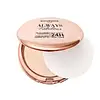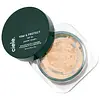Bourjois Paris Always Fabulous SPF 20 Powder Foundation Versus ciele. Filter & Protect SPF 30 Loose Finishing Powder
What's inside
What's inside
 Key Ingredients
Key Ingredients

 Benefits
Benefits

 Concerns
Concerns

 Ingredients Side-by-side
Ingredients Side-by-side

Mica
Cosmetic ColorantZinc Oxide
Cosmetic ColorantKaolin
AbrasiveZinc Stearate
Cosmetic ColorantDimethicone
EmollientButyloctyl Salicylate
Skin ConditioningBoron Nitride
AbsorbentTrimethylsiloxysilicate
EmollientSaccharomyces Ferment
Skin ConditioningSilica
AbrasiveTriethoxycaprylylsilane
1,2-Hexanediol
Skin ConditioningCaprylyl Glycol
EmollientSodium Benzoate
MaskingMethicone
EmollientAlumina
AbrasiveLauroyl Lysine
Skin ConditioningParfum
MaskingSodium Hyaluronate
HumectantHydrogen Dimethicone
Dimethylmethoxy Chromanol
AntioxidantBenzyl Salicylate
PerfumingCI 77891
Cosmetic ColorantIron Oxides
Mica, Zinc Oxide, Kaolin, Zinc Stearate, Dimethicone, Butyloctyl Salicylate, Boron Nitride, Trimethylsiloxysilicate, Saccharomyces Ferment, Silica, Triethoxycaprylylsilane, 1,2-Hexanediol, Caprylyl Glycol, Sodium Benzoate, Methicone, Alumina, Lauroyl Lysine, Parfum, Sodium Hyaluronate, Hydrogen Dimethicone, Dimethylmethoxy Chromanol, Benzyl Salicylate, CI 77891, Iron Oxides
Titanium Dioxide 12.5%
Cosmetic ColorantZinc Oxide 22.5%
Cosmetic ColorantDimethicone/Vinyl Dimethicone Crosspolymer
Skin ConditioningMica
Cosmetic ColorantPolymethylsilsesquioxane
Calcium Sodium Borosilicate
Butyloctyl Salicylate
Skin ConditioningTridecyl Salicylate
Skin ConditioningNiacinamide
SmoothingSilica
AbrasiveIsodecyl Salicylate
Skin ConditioningOctyldodecanol
EmollientDimethicone
EmollientIsoceteth-10
EmulsifyingIron Oxides
Phenylpropanol
MaskingPropanediol
SolventPhysalis Angulata Extract
Skin ProtectingCaprylic/Capric Triglyceride
MaskingMethicone
EmollientCaprylyl Glycol
EmollientTocopherol
AntioxidantTitanium Dioxide 12.5%, Zinc Oxide 22.5%, Dimethicone/Vinyl Dimethicone Crosspolymer, Mica, Polymethylsilsesquioxane, Calcium Sodium Borosilicate, Butyloctyl Salicylate, Tridecyl Salicylate, Niacinamide, Silica, Isodecyl Salicylate, Octyldodecanol, Dimethicone, Isoceteth-10, Iron Oxides, Phenylpropanol, Propanediol, Physalis Angulata Extract, Caprylic/Capric Triglyceride, Methicone, Caprylyl Glycol, Tocopherol
Ingredients Explained
These ingredients are found in both products.
Ingredients higher up in an ingredient list are typically present in a larger amount.
Butyloctyl Salicylate is a chemical UV filter structurally similar to octisalate. It is a photostabilizer, SPF booster, emollient and solvent. This ingredient helps evenly spread out ingredients.
According to a manufacturer, it is suitable for pairing with micro Titanium Dioxide, Zinc Oxide, and pigments.
Photostabilizers help stabilize UV-filters and prevents them from degrading quickly.
Learn more about Butyloctyl SalicylateCaprylyl Glycol is a humectant and emollient, meaning it attracts and preserves moisture.
It is a common ingredient in many products, especially those designed to hydrate skin. The primary benefits are retaining moisture, skin softening, and promoting a healthy skin barrier.
Though Caprylyl Glycol is an alcohol derived from fatty acids, it is not the kind that can dry out skin.
This ingredient is also used as a preservative to extend the life of products. It has slight antimicrobial properties.
Learn more about Caprylyl GlycolDimethicone is a type of synthetic silicone created from natural materials such as quartz.
What it does:
Dimethicone comes in different viscosities:
Depending on the viscosity, dimethicone has different properties.
Ingredients lists don't always show which type is used, so we recommend reaching out to the brand if you have questions about the viscosity.
This ingredient is unlikely to cause irritation because it does not get absorbed into skin. However, people with silicone allergies should be careful about using this ingredient.
Note: Dimethicone may contribute to pilling. This is because it is not oil or water soluble, so pilling may occur when layered with products. When mixed with heavy oils in a formula, the outcome is also quite greasy.
Learn more about DimethiconeMethicone is a type of silicone and is a simpler form of dimethicone.
Silicones are used to enhance the texture of products and have emollient properties. Methicone is used to give products a silky texture and improves spreadability.
Mica is a naturally occurring mineral used to add shimmer and color in cosmetics. It can also help improve the texture of a product or give it an opaque, white/silver color.
Serecite is the name for very fine but ragged grains of mica.
This ingredient is often coated with metal oxides like titanium dioxide. Trace amounts of heavy metals may be found in mica, but these metals are not harmful in our personal products.
Mica has been used since prehistoric times throughout the world. Ancient Egyptian, Indian, Greek, Roman, Aztec, and Chinese civilizations have used mica.
Learn more about MicaSilica, also known as silicon dioxide, is a naturally occurring mineral. It is used as a fine, spherical, and porous powder in cosmetics.
Though it has exfoliant properties, the function of silica varies depending on the product.
The unique structure of silica enhances the spreadability and adds smoothness, making it a great texture enhancer.
It is also used as an active carrier, emulsifier, and mattifier due to its ability to absorb excess oil.
In some products, tiny microneedles called spicules are made from silica or hydrolyzed sponge. When you rub them in, they lightly polish away dead skin layers and enhance the penetration of active ingredients.
Learn more about SilicaZinc Oxide is a mineral broad-spectrum UV filter; it is the broadest UVA and UVB reflector approved by the FDA. It also has skin protectant and skin soothing properties.
Zinc oxide is one of the most effective broad-spectrum UV filters. It protects against UVB, UVAII, and UVAI. In comparison to its counterpart titanium dioxide, zinc oxide provides uniform and extended UVA protection.
Another great benefit? This ingredient is highly photostable so it won't degrade easily under sunlight.
A common myth is that mineral UV filters are widely believed to primarily reflect UV light.
However, modern research shows titanium dioxide absorbs UV radiation like chemical filters (~95% absorption & 5% reflection).
Zinc oxide has great skin soothing properties so you'll likely find this in sunscreens formulated for sensitive skin or babies/children. It is unlikely to cause "eye sting" like other sunscreen ingredients.
Regulatory agencies consider zinc oxide to be non-toxic and safe. It has also been shown to not penetrate the skin.
Unfortunately, this ingredient does leave a visible white cast. This is why mineral sunscreens are often less cosmetically elegant than chemical or hybrid ones.
In cosmetics, zinc oxide can be found in both non-nano and nano-sized forms. The nano version is used to reduce white cast and improve the texture of sunscreen formulas.
There are ongoing concerns surrounding nano-zinc oxide's impact on marine ecosystems and whether it can be absorbed into skin.
Regarding marine ecosystems and coral reefs, there is no conclusive evidence that any form of zinc oxide (or any other sunscreen ingredients) will cause harm. The science is still developing but many consumers are keeping a close eye on this issue.
Please note, many destinations have reef-safety sunscreen rules. For instance, the U.S. Virgin Islands advises all visitors to use non-nano mineral sunscreens.
There has also been some stir about whether micronized or nano zinc oxide has potential photoxicity and absorption through the skin/lungs.
An in-vitro (done in a test tube or petri dish) study demonstrated micronized zinc oxide to have potential phototoxicity. There's no need to fret; the EU Commission's Scientific Committee on Consumer Safety has stated, "The relevance of these findings needs to be clarified by appropriate investigations in vivo." Or in other words, further studies done on living organisms are needed to prove this.
Current research shows zinc oxide nanoparticles do not penetrate intact or sunburned skin. They either remain on the surface or in the outermost layer of dead skin (stratum corneum).
Zinc oxide is one of only two classified mineral UV filters with titanium dioxide being the other one.
Fun fact: Zinc has been used throughout history as an ingredient in paint and medicine. An Indian text from 500BC is believed to list zinc oxide as a salve for open wound. The Ancient Greek physician Dioscorides has also mentioned the use of zinc as an ointment in 1AD.
Learn more about Zinc OxideThis ingredient is a combination of red, black, and yellow iron oxide pigments. This combination of colors is usually found in foundation, because it results in a "skin" color.